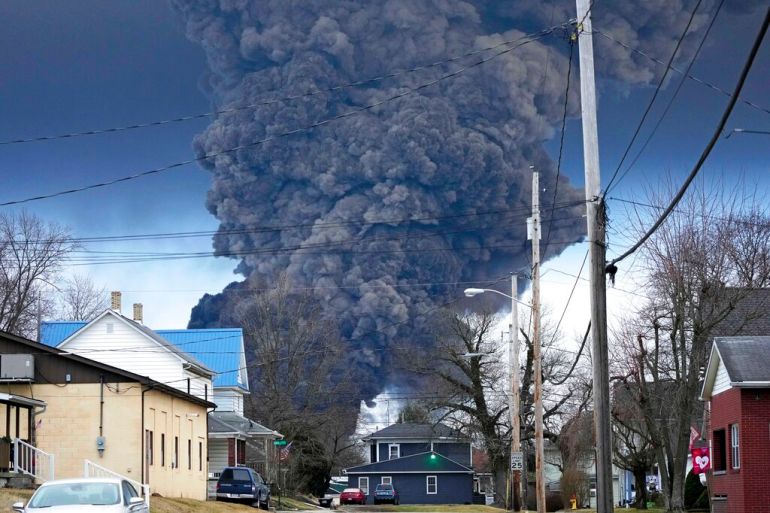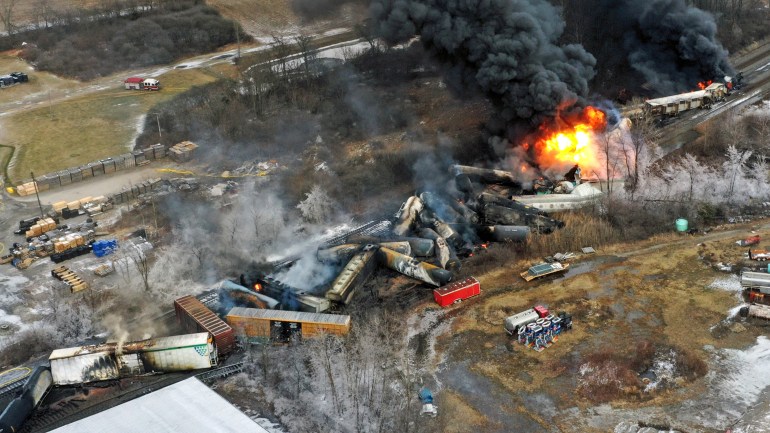US pledges more support after Ohio toxic train spill
Residents of East Palestine, Ohio, are demanding answers amid fears over health effects of toxic chemical spill.

Federal authorities in the United States have promised to provide continued support to a small Ohio community where a recent train derailment spilled toxic chemicals into the air and caused a massive fire, raising serious concerns for residents’ health.
Michael Regan, an administrator with the Environmental Protection Agency (EPA), told reporters on Thursday that the department “has not detected any levels of health concern” in air monitoring conducted since the fire was put out.
Keep reading
list of 3 itemsPhotos: Experts warn of ecological threat from Mayan Train route
California shooting underscores strain on state’s farmworkers
“We’re also continuing to conduct 24/7 air monitoring to ensure the health and safety of all residents,” Regan said during a news conference in East Palestine, the Ohio village of approximately 5,000 residents where the toxins-laden, freight train derailed on February 3.
“This incident has understandably shaken this community to its core,” said Regan, pledging to hold the railroad that operated the train, Norfolk Southern, “accountable” for cleanup and costs.
“Let me be clear: EPA will exercise our oversight and our enforcement authority under the law to be sure we are getting the results that the community deserves,” he said. “We will be here as long as it takes to ensure the health and safety of this community.”
US Health and Human Services staff, including from the Centers for Disease Control and Prevention, also are going to Ohio to provide support, President Joe Biden’s administration announced earlier in the day.
Ohio Governor Mike DeWine “asked for additional public health testing and assessments”, White House spokeswoman Karine Jean-Pierre told reporters at a daily briefing, adding that the federal health teams are deploying “now”.
The push came after hundreds of community members packed into a local high school gymnasium earlier this week to demand answers about the derailment, which sent smoke billowing over homes and businesses.
East Palestine Mayor Trent Conaway said at Wednesday’s information session that he wanted to help provide some reassurance for residents of the village, located about 84km (52 miles) northwest of the city of Pittsburgh on the Ohio-Pennsylvania border.
“We need our citizens to feel safe in their own homes,” Conaway said as the meeting began. “I need help. I’m not ready for this. But I’m not leaving, I’m not going anywhere.”
He added that Norfolk Southern was working closely with him. “They screwed up our town, they’re going to fix it,” the mayor said.
But those attending Wednesday’s meeting had many questions about health hazards, and demanded more transparency from the railroad operator, which did not send a representative to the information session.
In a statement, Norfolk Southern said it did not attend alongside local, state and federal officials because of a “growing physical threat to our employees and members of the community around this event”.
Danielle Deal, who lives a few kilometres from the derailment site, called that a “copout”. She and her two children left home to stay with her mother, 20km (13 miles) away, “and we could still see the mushroom cloud, plain as day”, she said.
I spoke w/ the White House early this morning to address the need for federal help in East Palestine. As a result of this conversation, I have requested assistance from the U.S. Dept of Health/Human Services, Health & Emergency Response Team, & CDC to provide direct support.
— Governor Mike DeWine (@GovMikeDeWine) February 16, 2023
Residents demand transparency
The train of three locomotives and 150 freight cars was headed from Illinois to Pennsylvania when it derailed. The National Transportation Safety Board (NTSB) said 20 of the cars were carrying hazardous materials, including 10 that derailed.
The NTSB, which has not commented on the cause of the incident, said 38 cars in total left the tracks while the ensuing fire damaged an additional 12.
Officials seeking to avoid an uncontrolled explosion evacuated the area where the train derailed and opted to release and burn toxic vinyl chloride from five rail cars, sending flames and black smoke billowing into the sky.
State officials have said that testing shows the air is safe to breathe around East Palestine, and they promised that air and water monitoring would continue.
During Thursday’s news conference, Regan at the EPA said the federal agency was supporting state and local authorities “in determining what impacts the spill has had on surface and groundwater and ensuring that the derailment has not had an effect on drinking water supplies”.
Regan also said that “no detections of vinyl chloride or hydrogen chloride were identified” in air-quality screenings at more than 480 homes in the area of the derailment.

But in the nearly two weeks since the incident forced thousands to evacuate, residents have complained about suffering from headaches and irritated eyes and finding their cars and lawns covered in soot.
The hazardous chemicals that spilled from the train killed thousands of fish, and residents have talked about finding dying or sick pets and wildlife.
Resident Kathy Dyke, who attended Wednesday’s information session, said she was concerned for her three grandchildren. “Are they going to grow up here in five years and have cancer?” she asked, urging the railroad to be more transparent.
“Why are they being hush-hush?” Dyke said. “They’re not out here supporting, they’re not out here answering questions. For three days we didn’t even know what was on the train.”
Norfolk Southern announced this week that it is creating a $1m fund to help the community while continuing to remove spilled contaminants from the ground and streams, as well as monitoring air quality.
“We are here and will stay here for as long as it takes to ensure your safety and to help East Palestine recover and thrive,” the company’s president and CEO, Alan Shaw, said in a letter to the community.
At least five lawsuits have been filed against the railroad, The Associated Press news agency reported.

Unknown risks
Meanwhile, experts have said much remains unknown about the dangers posed to residents by the toxins that spilled.
Erik Olson, the senior strategic director for health and food at the Natural Resources Defense Council, a non-profit group focused on the environment and public health, said the unknown risks vastly outweigh the reassurances that officials have given.
“This is clearly a very toxic brew of chemicals,” Olson said. “And I’ve not seen any public accounting for how many pounds or gallons of any of these chemicals that were released.”
The air and water testing that has been done so far seemed limited and “is not all that reassuring”, Olson added.
Ohio state officials have said that a plume of pollution in the Ohio River is moving at approximately 1.6km per hour (one mile per hour). But they said cities in the plume’s path can turn off their drinking water intakes as it floats by.
They have also said that drinking water tests have not raised concerns and normal water treatment would remove any small amounts of contaminants that may exist.
Gerald Poje, a toxicologist and a former founding member of the Chemical Safety Board, an independent federal agency that investigates industrial chemical accidents, said it could take months or years before the scale of the damage is fully known.
“This is a terrible tragedy in Ohio, it’s so painful to see so many lives put at risk,” Poje said. “There is a long challenge ahead of everybody into how to discern risks that are unknown at this moment in time.”